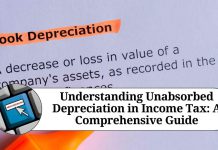Section 50C of the Income Tax Act, 1961, deals with the computation of capital gains or losses on the transfer of a capital asset being land or building or both. It was introduced to counter the practice of understating the actual sale consideration received by the seller and to bring transparency in real estate transactions.
Under Section 50C, if the consideration received or accruing as a result of the transfer of a capital asset being land or building or both, is less than the value adopted or assessed by the Stamp Valuation Authority for the purpose of payment of stamp duty, then such value adopted or assessed by the Stamp Valuation Authority will be deemed to be the full value of consideration for the purpose of computing capital gains under the Income Tax Act.
The provisions of Section 50C are applicable only if the following conditions are satisfied:
- The assessee has transferred a capital asset being land or building or both.
- The consideration received or accruing as a result of such transfer is less than the value adopted or assessed by the Stamp Valuation Authority for the purpose of payment of stamp duty.
The provisions of Section 50C are not applicable in the following cases:
- Where the actual consideration received by the assessee is higher than the value adopted or assessed by the Stamp Valuation Authority.
- Where the transfer of the capital asset takes place between relatives.
- Where the transfer takes place in a rural area.
The objective behind the introduction of Section 50C was to bring transparency in real estate transactions and curb the practice of under-reporting of sale consideration. It has proved to be an effective tool in achieving this objective. The provisions of Section 50C ensure that the actual sale consideration received by the seller is not understated and the correct amount of capital gains tax is paid.
One of the key features of Section 50C is that it applies even if the actual consideration received by the seller is lower than the value adopted or assessed by the Stamp Valuation Authority. This means that if the seller receives a lower amount of consideration due to any reason, such as a distress sale or a negotiated settlement, the full value of consideration for the purpose of computing capital gains will be deemed to be the value assessed by the Stamp Valuation Authority.
It is worth noting that the provisions of Section 50C also apply to cases where the transfer of a capital asset being land or building or both takes place as a result of a gift, will, or any other mode of transfer. In such cases, the value adopted or assessed by the Stamp Valuation Authority will be deemed to be the fair market value of the asset as on the date of transfer.
Another important aspect of Section 50C is that it provides an exception for cases where the transfer of the capital asset takes place between relatives. For the purpose of this provision, “relatives” include spouse, brother, sister, lineal ascendant or descendant, or spouse of any of the aforementioned persons. In such cases, the actual consideration received by the seller will be considered as the full value of consideration for the purpose of computing capital gains.
In addition, Section 50C also exempts transfers of capital assets in rural areas from its provisions. The term “rural area” is defined to mean any area which is not situated within the jurisdiction of a municipality or a cantonment board having a population of 10,000 or more. This exemption is aimed at providing relief to small landowners in rural areas who may not have access to reliable valuations of their assets.
It is also important to note that the provisions of Section 50C have been subject to judicial scrutiny in several cases. The courts have held that the value adopted or assessed by the Stamp Valuation Authority cannot be blindly accepted and must be examined on a case-to-case basis. The courts have also clarified that the provisions of Section 50C do not override the provisions of the Income Tax Act, such as the provisions relating to the determination of the fair market value of the asset.
In conclusion
Section 50C is an important provision of the Income Tax Act that is aimed at curbing the practice of under-reporting of sale consideration in real estate transactions. It ensures that the correct amount of capital gains tax is paid by deeming the value assessed by the Stamp Valuation Authority as the full value of consideration for the purpose of computing capital gains. However, it is important for taxpayers to be aware of the exceptions and judicial interpretations of this provision to avoid any legal consequences.
Read more useful content:
- section 234e of income tax act
- section 286 of income tax act
- section 90a of income tax act
- section 40a(7) of income tax act
- section 226(3) of income tax act
- section 24 of income tax act
Frequently Asked Questions (FAQs)
Q: What is Section 50C of the Income Tax Act?
A: Section 50C of the Income Tax Act, 1961, is a provision that deals with the computation of capital gains or losses on the transfer of a capital asset being land or building or both.
Q: When does Section 50C apply?
A: Section 50C applies if the consideration received or accruing as a result of the transfer of a capital asset being land or building or both is less than the value adopted or assessed by the Stamp Valuation Authority for the purpose of payment of stamp duty.
Q: Does Section 50C apply to all real estate transactions?
A: No, Section 50C does not apply to real estate transactions where the transfer takes place between relatives, or where the transfer takes place in a rural area.
Q: What is the Stamp Valuation Authority?
A: The Stamp Valuation Authority is a government authority that is responsible for determining the market value of a property for the purpose of stamp duty.
Q: What is the impact of Section 50C on capital gains tax?
A: Section 50C deems the value assessed by the Stamp Valuation Authority as the full value of consideration for the purpose of computing capital gains. This means that the actual consideration received by the seller may not be considered for the purpose of computing capital gains tax.
Q: Can the value assessed by the Stamp Valuation Authority be challenged?
A: Yes, the value assessed by the Stamp Valuation Authority can be challenged by the taxpayer. However, the burden of proof is on the taxpayer to show that the value assessed by the Stamp Valuation Authority is not the correct value.
Q: Is there any relief available for small landowners in rural areas?
A: Yes, transfers of capital assets in rural areas are exempt from the provisions of Section 50C. The term “rural area” is defined to mean any area which is not situated within the jurisdiction of a municipality or a cantonment board having a population of 10,000 or more.
Q: What is the penalty for non-compliance with Section 50C?
A: Non-compliance with Section 50C may result in penalties or legal consequences. The taxpayer may be required to pay additional tax, interest, or penalty for non-compliance.
Q: Can the provisions of Section 50C be overridden by other provisions of the Income Tax Act?
A: Yes, the provisions of Section 50C do not override the provisions of the Income Tax Act, such as the provisions relating to the determination of the fair market value of the asset.




















